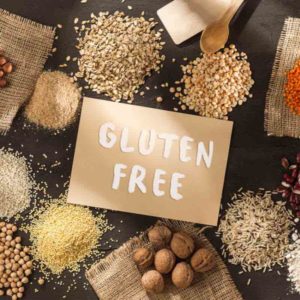
Now that you know what gluten is, it’s time to have fun exploring all the foods your child CAN eat! It may not be as challenging or monotonous as you think!
We’ve gotten to part 3 of our series! Now you know what a diagnosis of Celiac disease means, and where you can find gluten in food. Once your child has been diagnosed with celiac disease, she is one step closer to better health. It may be tough to accept at first, but obtaining a diagnosis is a good thing for long-term health. Since it is completely manageable with diet, you just need to know what to feed your child to manage the disease! Here are some of the basics you need to know when it comes to eating gluten-free.
What whole foods can my gluten-free child enjoy?
There are many foods that someone with celiac disease can eat that are naturally gluten-free. These items include fruits, vegetables, beans, gluten-free grains, nuts, dairy, seafood, poultry, and meat. These foods are naturally gluten-free, but as always, put on your detective hat with different brands to make sure you don’t find any added gluten-containing ingredients. Also, make sure you read the label of anything in a package- this tip can’t be said enough! You may find that you can easily use or find substitutes that are gluten-free that have a similar taste. For instance, there are gluten-free flour blends, and you can use cornstarch instead of flour as a thickener.
What new habits should I start in the kitchen?
It is very important that your cooking methods do not introduce cross-contamination. For example, you don’t want to grill gluten-free foods with foods that have gluten-containing sauces or buns. Here are a few things to keep in mind:
- If you use one toaster oven for the whole family, always make sure to clean and take precautions. You can have two racks, and keep the top one gluten-free. This involves cleaning the racks after you use them. You can also choose to use aluminum foil for extra precaution! Pop-up toasters are NOT recommended to be shared.
- You can share cutting boards, but they need to be cleaned thoroughly with soap and water before preparing gluten-free foods. Another choice is to have a designated gluten-free board!
- Strainers for pasta shouldn’t be shared as they are very difficult to clean even with soap and water. You should have a separate gluten-free strainer for your child.
What are the grains I can use in cooking?
Choosing a variety of naturally gluten-free grains can help boost you and your child’s nutritional profile while making sure the whole family still approves and loves the flavor. Here are some naturally gluten-free grains to experiment with:
- Amaranth
- Brown rice
- Quinoa
- Teff
- Buckwheat
- Millet
- Oats (labeled GF) – take a look at our quick facts on oats from the previous article
Also, many starchy foods like yams and purple potatoes, or squash such as spaghetti squash and butternut squash, are naturally gluten-free and high in nutrients!
What gluten-free labels can I trust?
Many food manufacturers will label packaged foods as gluten-free. Foods labeled as “gluten-free (GF)” go beyond the trend and provide meaning for those maintaining a gluten-free diet. The GF label or symbol does not mean it is a healthier product, but in the US, it means that it contains less than 20 parts per million (ppm). This is an amount deemed acceptable by the Food and Drug Administration (FDA). Manufacturers recognize the selling power their products have with this claim, and they will usually put “gluten-free” in a prominent, hard to miss position. However, it can be anywhere on the box or package. Some manufacturers choose to put a GF logo developed by third-party certification programs on their packaging – sometimes this means even stringent testing requirements such as <5ppm. However, the FDA does not endorse, accredit, or recommend any particular third-party gluten-free certification program. Here are some gluten-free brands to try.
What extra precautions should I take?
People who are newly diagnosed with celiac disease or have lingering symptoms may be advised to be a little more careful in taking risks with foods that may be cross contaminated. Generally, you always want to avoid foods that state that foods were manufactured on equipment shared by gluten-containing foods. So, it is important to work with your healthcare providers, especially your dietitian to make sure you are doing everything in your control to help prevent undesired symptoms.
To top this whole series off, we went to a celiac disease expert dietitian to learn The Real Truth About Gluten-Free and Celiac. Read what she had to say in part 4 of our series!
If you missed parts 1 and 2, head back to What Does My Child’s Celiac Diagnosis Mean? and Where Do You Find Gluten in Food?.












